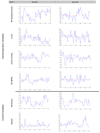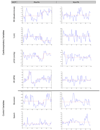Change point analysis for longitudinal physiological data: detection of cardio-respiratory changes preceding panic attacks
- PMID: 20144682
- PMCID: PMC2978268
- DOI: 10.1016/j.biopsycho.2010.01.020
Change point analysis for longitudinal physiological data: detection of cardio-respiratory changes preceding panic attacks
Abstract
Statistical methods for detecting changes in longitudinal time series of psychophysiological data are limited. ANOVA and mixed models are not designed to detect the existence, timing, or duration of unknown changes in such data. Change point (CP) analysis was developed to detect distinct changes in time series data. Preliminary reports using CP analysis for fMRI data are promising. Here, we illustrate the application of CP analysis for detecting discrete changes in ambulatory, peripheral physiological data leading up to naturally occurring panic attacks (PAs). The CP method was successful in detecting cardio-respiratory changes that preceded the onset of reported PAs. Furthermore, the changes were unique to the pre-PA period, and were not detected in matched non-PA control periods. The efficacy of our CP method was further validated by detecting patterns of change that were consistent with prominent respiratory theories of panic positing a relation between aberrant respiration and panic etiology.
Copyright © 2010 Elsevier B.V. All rights reserved.
Figures


Similar articles
-
Do unexpected panic attacks occur spontaneously?Biol Psychiatry. 2011 Nov 15;70(10):985-91. doi: 10.1016/j.biopsych.2011.05.027. Epub 2011 Jul 23. Biol Psychiatry. 2011. PMID: 21783179 Free PMC article.
-
Autonomic reactivity of panic patients during a CO2 inhalation procedure.Depress Anxiety. 2000;11(1):15-26. doi: 10.1002/(sici)1520-6394(2000)11:1<15::aid-da3>3.0.co;2-w. Depress Anxiety. 2000. PMID: 10723631
-
Physiologic instability in panic disorder and generalized anxiety disorder.Biol Psychiatry. 2001 Apr 1;49(7):596-605. doi: 10.1016/s0006-3223(00)01000-3. Biol Psychiatry. 2001. PMID: 11297717
-
Panic disorder and control of breathing.Respir Physiol Neurobiol. 2009 May 30;167(1):133-43. doi: 10.1016/j.resp.2008.07.011. Epub 2008 Jul 25. Respir Physiol Neurobiol. 2009. PMID: 18707030 Review.
-
Physiological markers for anxiety: panic disorder and phobias.Int J Psychophysiol. 2005 Nov-Dec;58(2-3):190-8. doi: 10.1016/j.ijpsycho.2005.01.015. Epub 2005 Aug 30. Int J Psychophysiol. 2005. PMID: 16137780 Review.
Cited by
-
Predicting Imminent Aggression Onset in Minimally-Verbal Youth with Autism Spectrum Disorder Using Preceding Physiological Signals.Int Conf Pervasive Comput Technol Healthc. 2018 May;2018:201-207. doi: 10.1145/3240925.3240980. Int Conf Pervasive Comput Technol Healthc. 2018. PMID: 30420938 Free PMC article.
-
Hyperventilation in panic disorder and asthma: empirical evidence and clinical strategies.Int J Psychophysiol. 2010 Oct;78(1):68-79. doi: 10.1016/j.ijpsycho.2010.05.006. Epub 2010 May 25. Int J Psychophysiol. 2010. PMID: 20685222 Free PMC article. Review.
-
Temporal stability and coherence of anxiety, dyspnea, and physiological variables in panic disorder.Biol Psychol. 2010 Oct;85(2):226-32. doi: 10.1016/j.biopsycho.2010.07.005. Epub 2010 Jul 14. Biol Psychol. 2010. PMID: 20637257 Free PMC article.
-
Can Interoception Improve the Pragmatic Search for Biomarkers in Psychiatry?Front Psychiatry. 2016 Jul 25;7:121. doi: 10.3389/fpsyt.2016.00121. eCollection 2016. Front Psychiatry. 2016. PMID: 27504098 Free PMC article. Review.
-
DeCon: a tool to detect emotional concordance in multivariate time series data of emotional responding.Biol Psychol. 2014 Apr;98:29-42. doi: 10.1016/j.biopsycho.2013.10.011. Epub 2013 Nov 9. Biol Psychol. 2014. PMID: 24220647 Free PMC article.
References
-
- Ayala ES, Meuret AE, Ritz T. Confrontation with blood and disgust stimuli precipitates respiratory dysregulation in blood-injury-injection phobia. Biological Psychology. (in revision) - PubMed
-
- Basseville M, Nikiforov I. Detection of Abrupt Changes: Theory and Application. Englewood Cliffs, NJ: Prentice-Hall; 1993. 1993.
-
- Biedler AE, Wilhelm W, Kreuer S, Soltesz S, Bach F, Mertzlufft FO, et al. Accuracy of portable quantitative capnometers and capnographs under prehospital conditions. The American Journal of Emergency Medicine. 2003;21:520–524. - PubMed
-
- Chang BS, Ives JR, Schomer DL, Drislane FW. Outpatient EEG monitoring in the presurgical evaluation of patients with refractory temporal lobe epilepsy. Journal of Clinical Neurophysiology: Official Publication of the American Electroencephalographic Society. 2002;19:152–156. - PubMed
-
- Clark DM. A cognitive approach to panic. Behavior Research and Therapy. 1986;24(4):461–470. - PubMed
MeSH terms
Grants and funding
LinkOut - more resources
Full Text Sources
Other Literature Sources
Medical
Miscellaneous

